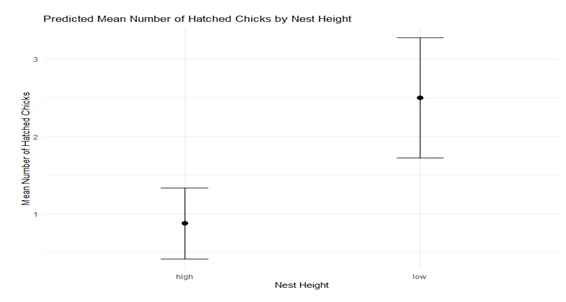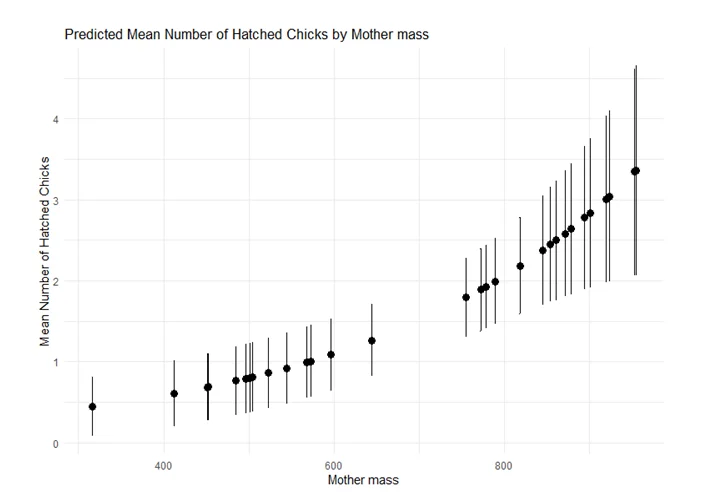- Problem Description: Analyzing Factors Impacting Parasite Prevalence and Gull Chick Hatching Success
- Question 1: Understanding Parasite Prevalence in Fish
- Objective:
- Question 1: The Influence of Temperature and Species on C. irritans Presence in Fish
- Part a: Temperature Impact
- Part b: Species Comparison
- Part c: Random Effects in GLMM
- Part d: Biological Interpretations
- Question 2: Factors Affecting Gull Chick Hatching Success
- Objective:
In the dynamic realm of ecology, understanding the intricate interactions between species and their environment is paramount. Our investigation delves into two critical aspects of ecological science. We explore the factors influencing the prevalence of C. irritans in fish populations, shedding light on the dynamics of aquatic ecosystems and fisheries management. Simultaneously, we unravel the secrets behind gull chick hatching success, unveiling the complex web of biological and environmental elements shaping avian life. These analyses provide essential insights for conservation efforts and ecosystem management, enriching our understanding of these natural systems.
Problem Description: Analyzing Factors Impacting Parasite Prevalence and Gull Chick Hatching Success
In this comprehensive analysis, we explore two distinct ecological challenges:
Question 1: Understanding Parasite Prevalence in Fish
Background: The presence of the parasite C. irritans in fish populations is a concern for both aquatic ecosystems and the fisheries industry. To better comprehend the dynamics of this parasite and its effects, we investigate the impact of various factors on its prevalence.
Objective:
- Examine how water temperature influences the likelihood of C. irritans presence in fish.
- Compare the susceptibility of two different fish species, A and B, to C. irritans infection.
- Account for the non-independence of data collected from multiple tanks through the application of random effects in generalized linear mixed models (GLMM).
Significance:
Understanding the factors that affect parasite prevalence is crucial for fisheries management and conservation efforts. This knowledge aids in predicting the spread of parasites and their potential consequences for aquatic ecosystems.
Question 1: The Influence of Temperature and Species on C. irritans Presence in Fish
Part a: Temperature Impact
In this part, we investigate the influence of water temperature on the presence of the parasite C. irritans in fish. We employ a generalized linear model (GLM) with a binomial distribution and a logit link function. The model indicates a strong relationship between temperature and susceptibility to C. irritans, suggesting that as water temperature increases, the likelihood of the parasite's presence also rises. The odds ratio estimate supports this finding, showing a statistically significant effect of temperature on susceptibility to the parasite. Furthermore, the Chi-squared test for Pearson's residuals reveals evidence of overdispersion, implying that the assumption of a binomial distribution with a logit link may not be entirely appropriate.
Part b: Species Comparison
This section focuses on comparing two fish species, A and B, in terms of their susceptibility to C. irritans. We employ a GLM to estimate the odds of parasite presence between the two species. The results demonstrate a significant difference, with species B exhibiting a higher likelihood of C. irritans presence compared to species A. The odds ratio estimate and confidence interval reinforce this conclusion. Unlike the previous section, there's no evidence of overdispersion, indicating that the model's assumptions are reasonable.
Part c: Random Effects in GLMM
To account for the non-independence of data points from the same "tank," we utilize a generalized linear mixed model (GLMM). This model assesses the effects of both temperature and species on C. irritans presence while including a random intercept for the "tank" variable. The random effect introduces variability at the tank level, providing different intercepts for each tank. This approach improves the modeling accuracy by considering the clustered nature of the data.
Part d: Biological Interpretations
This section delves into the biological relevance of the results. For temperature, we observe that higher water temperatures correlate with an increased probability of C. irritans infection in fish. This implies that temperature plays a critical role in the parasite's prevalence and distribution, potentially impacting fish health.
In the species comparison, we find that species B is significantly more susceptible to C. irritans compared to species A. This variation may result from biological factors such as differences in immune systems or habitat preferences. The odds ratio estimates and confidence intervals reinforce the statistical significance of this difference.
Question 2: Factors Affecting Gull Chick Hatching Success
Background: Nesting success in gulls is a critical aspect of avian ecology. The number of successfully hatched gull chicks per nest is influenced by various environmental and biological factors. We aim to investigate the factors affecting hatching success.
Objective:
- Analyze the influence of nest height on the number of successfully hatched gull chicks per nest.
- Evaluate the impact of the mother's mass on chick hatching success.
- Assess whether the distribution of the data exhibits overdispersion or underdispersion.
Significance: Understanding the drivers of hatching success in gulls contributes to the broader understanding of avian reproductive strategies and population dynamics. This knowledge can inform conservation practices and ecosystem management.
Part a: Nest Height This section evaluates the effect of nest height (low or high) on the number of successfully hatched gull chicks per nest. A Poisson GLM is utilized to analyze count data. The dispersion parameter is assessed to determine whether overdispersion or underdispersion is present. 
Part b:Predicted Mean Number of Hatched Chicks Predicted mean numbers of hatched chicks are presented for nests at different heights, along with their 95% confidence intervals, to understand the relationship between nest height and chick hatching success.
Part c:Mother Mass Impact This part investigates the impact of the mother's mass on the number of hatched gull chicks. A Poisson GLM is employed to assess the relationship, and the dispersion parameter is examined to understand the distribution fit.

Part d: Biological Interpretations A plot is provided to visualize the relationship between mother mass and the mean predicted number of hatched chicks, along with confidence intervals. The biological relevance is discussed, suggesting that larger mothers may contribute to higher chick-hatching success due to their ability to provide resources and care.
Related Sample
Explore our extensive collection of Biostatistics assignment samples, meticulously crafted to aid your understanding of statistical concepts in the realm of biology and healthcare. Delve into diverse topics such as clinical trials, epidemiology, and experimental design through our comprehensive examples, designed to enrich your learning experience. Unlock insights and techniques crucial for mastering Biostatistics with our curated assortment of practical assignments and case studies. Immerse yourself in real-world scenarios and sharpen your analytical skills to excel in the field of biostatistics.
Biostatistics
Biostatistics
Biostatistics
